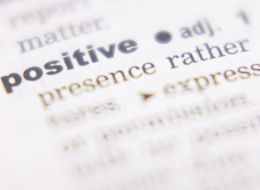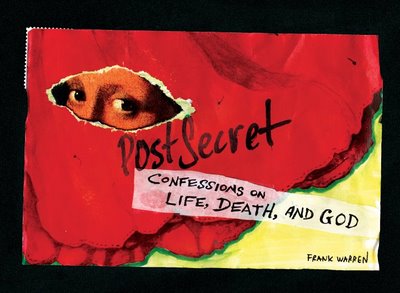
I absolutely love this post that Tamar Chansky, Ph.D., wrote specifically for Beyond Blue! You may remember her from another interview I did with her. She is a clinical psychologist, author of “Freeing Your Child From Negative Thinking” and other books, and a Huffington Post blogger. She’s an expert on negative thinking — how to turn it around to work for you. So I asked her to set us straight on what we should do with positive thinking, because the research is mixed. Voila! Here is her explanation, which I find VERY helpful, possibly brilliant.
Just when it seemed that the laws of modern life couldn’t get any more complicated–do you do facebook or just twitter: for the last time, what is twitter anyway? we seem to be getting conflicting advice about what should be going on in the privacy of our own minds. Think positively! Don’t think positively! Pursue happiness! Happiness is a trap! Negative thinking is bad for your health! Being “bright-sided” by positive thinking, as Barbara Ehrenreich recently warned, is bad for your health! What’s a thinking person to do?
Though it seems baffling and at times impossible to distinguish the “right” ways to think from the “wrong,” a few simple rules apply. Maybe not as few as eco-health guru Michael Pollan offers for our diet, but if we translate the gist of his message: eating real (unadulterated, minimally processed) food is good for you– into a psychological context, the message becomes: thinking real or true thoughts (whether joyous or sorrowful) is good for you. Tampering with the truth in our thinking in any direction–whether making it either more positive or negative is not. Bottom line: we shouldn’t try to say anything to ourselves that would require us to cross our fingers behind our back.
Sometimes we won’t like it–the bitter kale and collards of life–but just as vegetables won’t disappear from a fussy child’s plate as much as he pouts, protests, or even douses it with condiments, we too must digest our struggles directly, and yes, ultimately it is good for us. Pretending or dressing them up won’t make tough realities any easier to swallow, breaking it down bite-by-bite will. True joy requires no further instructions or encouragement to savor or even devour, the problems start when we try to add false joy or positivity to sugar coat the truth in order to transform a negative into a positive. Life–even when it’s tough– doesn’t require artificial colorings or additives to make it palatable.
What’s Wrong with Positive Thinking?
Positive Thinking could be considered the high fructose corn syrup of the thinking world– when forced. It’s not necessary, natural, and research has found that it’s not good for us when we have to sell ourselves on it.
All of us feel upset from time to time, and can, depending on the day or our temperament, slip or sprint into a place of self-loathing, world-loathing, hell. When we are in that place we don’t need to be airlifted to Disney, we just want to re-route our perfect nose-dive towards utter misery. Just about any other destination will do. In that state of despair, the last logical thing to do–even it were humanly possible–is to do a back-breaking reach for the positive. If our children did that kind of maneuver in the middle of a tantrum we’d take their temperature or call an exorcist. Why? Because in that moment we are essentially lying to ourselves. There’s no rationale for it. Fake stuff doesn’t work: nutritionally or emotionally.
Positive thinking is not wired in. We don’t necessarily need it to survive. Cavemen didn’t need to whistle while they hunted or gathered; in fact whistling would have certainly blown their cover from the wooly mammoths. On the other hand, negative thoughts–the what if’s and oh no’s of life–are wired in. They are the handy neural first-responders which, by erring on the side of caution, kept us in our caves when the wind rustled the sticks on the ground in case it might have been a hungry wooly mammoth. But now in these civilized times, these warnings of danger or defeat are overprotective troublemakers. We shouldn’t be surprised when we have them, or feel defeated: they are pre-set from the factory, but nor should we stop, drop and hang on their every word. We need to understand them as well-intentioned, but antiquated alarmists.
When we are having a bad day the alarm sounds like this: my life is a total disaster, nothing will ever work for me, I’m a total failure, but then if we try to fix it with a 180: my life is great; I can make anything work for me if I try, I can get anything done that I put my mind to, we may start to get the feeling like we want to punch something, even though we’re peaceful people.
The problem is that the original statement is a lie–it’s an exaggeration in a negative direction of what is happening: True, we may be having an off moment, but that has little to do with what we’re capable of in general. It’s apples and oranges. Notice how the solution, the so-called positive statement, is yet another exaggeration–a lie in the opposite direction. We’re trying to fix an unwieldy problem with an unwieldy solution. In the therapy field, we call that a “more of the same” strategy–it doesn’t solve the problem, it doubles it.
In fact research has shown just this–when depressed people attempt to say positive statements in response to their depression, their self-esteem plummets. Researchers from the University of Waterloo in Canada found that for people suffering from low-self esteem reaching for the positive backfired–people felt worse about themselves after saying positive affirmations than they did before.
Question: If Positive Thinking Doesn’t Work, What Do We Do with Negative Thinking?
Answer: Get Specific: Edit and Insert Modifiers to Right-Size the Problem
Think: truth in labeling. Negative thinking starts with some kernel of the truth– for example, let’s say we aren’t happy with how we look one day, or with news we receive–but then it extends, expands and sensationalizes that news into a whole new theory about ourselves, casting doom and gloom as far as the mind can imagine. And all in a no fuss, no muss, effortless way, faster than the speed of light. Remember, that is the just the way the antiquated system is set up. Our job is to not buy into the National Enquirer version of our lives–those eye-catching catastrophic headlines that are too bad to be true; instead cultivate a different interpretation or spin on the story, soliciting the factual if dry Scientific American version. We will be feeling better because we’ll be thinking more accurately. How do we do this?
Let’s go back to our bad day. With some editing: my life is a total disaster, nothing will ever work for me, I’m a total failure becomes: right now I’m feeling like things aren’t working for me, this day didn’t go smoothly, this project has a glitch in it, and that’s making me feel like a failure–I know this is temporary. When I work it out, and I will, I won’t feel this way any more.
Now, we might not be jumping up and down for joy with this solution–but remember, we don’t crave jumping up and down for joy or at least we don’t need that as a sustained state of being, we do however, need to know how to get unstuck from negative pulls, and separating facts from feelings and using accurate modifiers like–right now, not yet, for the moment, or sometimes essentially raises us up out of the deep think hole we slipped into by pinpointing or right-sizing the original trigger for the fall, the straw that broke the camel’s back.
Beyond Just Negating the Negative: The Opposite of Negative Thinking isn’t Positive Thinking, It’s Possible Thinking
Normally when we are in a negative state we narrow our perspective and insist that there is one and only one solution that will make us feel better– I just need to get that job; If he would just call, everything would be fine; If only I could lose 10 pounds, I’d be happy, etc. Narrowing the problem down is a good thing, but narrowing the solutions, not so good. Getting our minds working on stretching and broadening the possible responses or next steps is our goal.
How can we expand our vision to other points of view? A friend of mine told me that she has a group of mentors she refers to as her “Board of Directors.” These are trusted friends and colleagues to whom she turns for advice on a regular basis. Imagine establishing your own Board–staffed with people real or imaginary–whose guidance and opinions (or even sense of humor) you’d like to turn to in a tough negative moment. The Dalai Lama? Your wise grandmother? Bart Simpson? They don’t need to know, and you don’t have to supply the coffee and donuts when you assemble your meeting–the beauty of it is that it’s all in your head and in this instance, that’s a good thing. Just stepping out of the “me, me, me” take on our lives instantly frees us up, any additional wisdom we may glean from these trusted advisors is gravy.
When is it OK to be Positive? When It’s Real
If we are taking “truth” as our barometer, of course it’s ok to be positive–because genuine joy and happiness–dispersed in wonderful though fleeting installments–is authentic. Whether we are moved by the birth of a baby–touched by watching two kids walking hand in hand to school, tickled by getting an email from an old boyfriend, serene looking at a the light coming through the trees out our window (or thrilled to be collaborating with Therese Borchard)–we feel it and it’s good.
These feelings are not manufactured or tinkered with, not labored over in the fields or factories of our minds, they are spontaneous. So, welcome spontaneous positive thoughts, but don’t knock yourself out trying to fashion them out of thin air when they just aren’t there.
***
If we all follow these Pollan-esque instructions as we make our way down the aisles of our mind, we will cultivate and harvest what is real– whether it be joy, sorrow or anything in between– knowing that we are fully capable of digesting it safely. We won’t get dragged around by what is manufactured and overly processed in the dark places in our minds, but instead will stick with what helps us grow.
©Tamar Chansky, Ph.D., 2009
You can check out Tamar Chansky’s books by visiting her website, or read her blog on the Huffington Post. Of course, you can follow her on Twitter too.
* Click here to subscribe to Beyond Blue and click here to follow Therese on Twitter and click here to join Group Beyond Blue, a depression support group. Now stop clicking.

